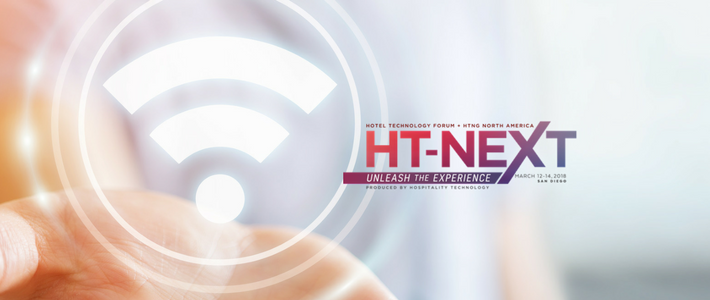6 Things We Learned About Wi-Fi Strategy at HT-NEXT

Last week some of our team members joined hospitality's brightest minds to talk technology at the HT-NEXT conference in San Diego. We engaged in meaningful conversations, attended informative sessions, and came home with several great insights about how hotel brands develop their Wi-Fi strategy for today—and tomorrow.
1. Simple is better (but not easier) when it comes to SSIDs
While brands take different approaches to how they manage and name their SSIDs, everyone can agree that a big scrolling list of SSIDs is not a great guest experience. In general, best practice is to limit the number of SSIDs for:
- Guest rooms: give paying hotel guests a premium connection
- Public areas: offer free basic connection for visitors and guests
- Conference areas: add value for attendees and create revenue opportunities
While it may seem like an easy a problem to solve, many brands still struggle to create a consistent experience, even when it comes to naming their guest networks. That's because of the disparate systems, suppliers, and staff at each property. A Wi-Fi management platform is key to creating a seamless guest experience, including control over the naming conventions of SSIDs across brands and locations.
2. Automatic authentication is not the future, it's here
Automatic authentication should be at the core of your network strategy. Guests expect Wi-Fi that is:
- Free: this was the focus for the last few years; there are options for up-sell, but Wi-Fi should not be relied on as a direct revenue-producer.
- High-performance: this is the most recent focus, especially around density; 5-6MB is recommended for streaming media, browsing, etc.
- Homelike: this is where we're heading; a frictionless connection that works just like it does at home and we don't have to think about it.
While it could take a couple years for brands to roll out automatic authentication for lifetime connection, it's no longer just a cool idea, it's reality. The leading technology that enables automatic authentication is Wi-Fi CERTIFIED Passpoint® (a.k.a. Hotspot 2.0 or HS 2.0). MAC re-authentication is a simpler more ubiquitous option, but not as secure or future-proof. Learn more about the difference between Passpoint and MAC re-auth in our blog post, What is Automatic Wi-Fi Authentication?
3. 5G won't replace Wi-Fi in the near future
The recent development of 5G has forced us all to wonder, will it replace Wi-Fi? The general consensus was no, or at least not anytime soon. While 5G does have more capacity, Wi-Fi infrastructure has a massive head start. Plus, hoteliers, in general, are capping bandwidth around 5-6MB (plenty to support streaming and other typical guest behaviors) so the capacity isn't a near-term issue. Today, pricing on 5G is too high to make the transition realistic.
In terms of strategy, it's important that hoteliers continue to invest in Wi-Fi infrastructure and address the implications of 5G and carrier/mobile connection. For example, when building out a new hotel, it's best practice to do a cell phone signal audit to ensure guests can use their phones.
4. Plan for GPON, but don't rule out ethernet
Ethernet is the most common form of LAN today and Gigabyte Passive Optical Networks (GPON) is newer tech that relies on optical cables to deliver information. Most experts agreed that GPON will eventually be the LAN infrastructure of choice in hotels, but it could still be 15-20 years before we see it take over. The industry is slow to make major changes—it could be up to the major brands to show the value of GPON so that suppliers, owners, managers, and other brands follow suit.
GPON is a green solution that future-proofs network infrastructure because it does not require as much cabling (and cabling is expensive). Also, the bandwidth capacity is higher than ethernet. Overall, the consensus is that GPON is the future because it furthers the industry towards true network convergence.
5. Network "self-healing" tops wishlists of major brands
As more technology moves to the cloud and becomes smarter, it's no surprise that many "wouldn't it be cool if..." statements centered around proactive diagnosis and self-healing.
- Wouldn't it be cool if we knew a guest was struggling with Wi-Fi access before they lodge a complaint?
- Wouldn't it be cool if we instantly knew an AP was down and traffic could be automatically re-routed until it was fixed?
- Wouldn't it be cool if we didn't even have to know something was wrong and the network fixed itself?
In fact, the interest goes beyond network health and extends to all hotel technology. As the Internet of Things (IoT) grows, more and more devices are coming online, and therefore the risk of technology failure increases. With the rise of machine learning (ML) and artificial intelligence (AI), self-healing and proactive diagnostic tools are completely possible.
6. Wi-Fi bridges the gap between business & IT strategy
Each year, we notice more executives from the business side gathering at the table to talk Wi-Fi and this year was no exception. Being the #1 most demanded amenity, Wi-Fi has an undeniable affect on loyalty. If hotels fail to deliver a fast and consistent connection, guests will go looking for it somewhere else. It's really that simple.
Wi-Fi also presents unique opportunities to get to know guests better. Not just what devices and browsers they use a but how move through your hotel and how to offer relevant and timely promotions. Lifetime connection is also a great perk to drive app downloads and loyalty program sign-ups. Wi-Fi really goes beyond connecting guests to the network, it enables better connection between brands and guests.
Ready to start building your Wi-Fi strategy? Contact us for a Wi-Fi consultation.
Passpoint is a registered trademark of Wi-Fi Alliance®.